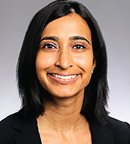The two main classes of immune checkpoint inhibitors used to treat non–small cell lung cancer (NSCLC) have essentially the same efficacy and toxicity profiles, according to a systematic review and meta-analysis of 23 trials with a total of 5,899 patients.1

The efficacy of these agents appears to be similar in terms of overall response rate in an unselected population of NSCLC patients.— Rathi N. Pillai, MD
Tweet this quote
Results showed that about one-fifth of patients had a tumor response, and a similar proportion experienced grade 3 or worse toxicity—regardless of whether they were treated with antibodies targeting the programmed cell death protein 1 (PD-1) receptor or antibodies targeting one of its ligands, programmed cell death ligand 1 (PD-L1), first author Rathi N. Pillai, MD, reported at the 2016 World Conference on Lung Cancer. The rate of immune-related adverse events was an absolute 5% higher with the PD-1 inhibitors, however.
“The efficacy of these agents appears to be similar in terms of overall response rate in an unselected population of NSCLC patients,” she commented. And “the rate of overall adverse events is similar.”
“The limitation of this work is that this is a retrospective analysis, and we did not have access to complete toxicity reporting in all of the studies,” acknowledged Dr. Pillai, who is Assistant Professor in the Department of Hematology and Medical Oncology of the Winship Cancer Institute at Emory University, Atlanta.
Antibodies that target PD-1, found on the surface of activated T cells, and PD-L1, a ligand overexpressed by many tumors, induce antitumor responses by inhibiting T-cell downregulation. As more have become available for treating NSCLC, questions have arisen regarding their relative benefits and harms, but head-to-head comparisons in this setting are lacking.
Study Details and Findings
Dr. Pillai and her co-investigators searched public databases and conference proceedings for trials reported between 2013 and 2016 that used PD-1 inhibitors—nivolumab (Opdivo) or pembrolizumab (Keytruda)—and trials that used PD-L1 inhibitors—atezolizumab (Tecentriq), durvalumab (also known as MEDI4736), or avelumab (also known as MSB0010718C)—in patients with NSCLC. Meta-analyses were based on 12 trials of PD-1 inhibitors in 3,284 patients and 11 trials of PD-L1 inhibitors in 2,615 patients.
PD-1 vs PD-L1 Inhibitors in Advanced NSCLC
- A meta-analysis of 23 trials of 5,899 patients with advanced NSCLC found that the overall response rate did not differ significantly between those given a PD-1 inhibitor (19%) and those given a PD-L1 inhibitor (17%).
- The rate of any-grade adverse events was statistically indistinguishable with PD-1 and PD-L1 inhibitors (72% and 65%), but the rate of any-grade immune-related adverse events was higher with the former (16% vs 11%, P = .04)
- The most common any-grade adverse event was fatigue, and the most common any-grade immune-related adverse event was hypothyroidism.
Results showed no significant difference in the response rate between patients treated with PD-1 inhibitors and counterparts treated with PD-L1 inhibitors (19% and 17%, respectively), Dr. Pillai reported.
Similarly, there were no significant differences in the rates of any-grade adverse events (72% and 65%); grade 3 or worse adverse events (22% and 21%); or the rates of fatigue, diarrhea, and rash individually. For both classes of agents, fatigue was the most common any-grade event, occurring in about one-fifth of patients.
Immune-related adverse events of any grade were more common with PD-1 inhibitors (16% vs 11%, P = .04), but those of grade 3 to 5 were not (3.1% and 6%). There was a trend toward a higher rate of hypothyroidism—the most common immune-related adverse event reported—with PD-1 inhibitors (6.7% vs 4.2%, P = .07); and although rare, pneumonitis was twice as common (4% vs 2%, P = .01). The rate of colitis was statistically indistinguishable between inhibitor classes.
When specific drugs were evaluated, the rate of any-grade adverse events was 76% with nivolumab, 67.5% with pembrolizumab, 65% with atezolizumab, 60.6% with durvalumab, and 67% with avelumab. ■
Disclosure: Dr. Pillai reported no potential conflicts of interest.
Reference

